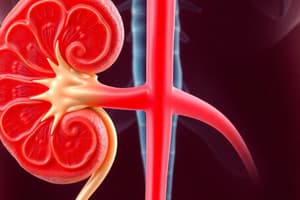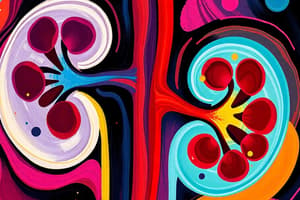Podcast
Questions and Answers
Which of the following best describes the primary role of the kidneys in maintaining electrolyte balance?
Which of the following best describes the primary role of the kidneys in maintaining electrolyte balance?
- Secreting hormones that regulate electrolyte absorption in the intestines.
- Storing excess electrolytes for later use by the body.
- Filtering electrolytes from the blood and excreting them in urine or returning them to the bloodstream as needed. (correct)
- Producing electrolytes to compensate for dietary deficiencies.
A patient's urine specific gravity is measured at 1.035. What does this result indicate?
A patient's urine specific gravity is measured at 1.035. What does this result indicate?
- The patient's urine is within the normal range.
- The specific gravity result is not related to the patient's hydration status.
- The patient's urine is concentrated, possibly indicating dehydration. (correct)
- The patient's urine is dilute, possibly indicating overhydration.
How does the aging process typically affect bladder capacity?
How does the aging process typically affect bladder capacity?
- Bladder capacity remains constant throughout adulthood.
- Bladder capacity increases due to decreased muscle tone.
- Bladder capacity decreases, leading to more frequent urination. (correct)
- Bladder capacity fluctuates widely depending on fluid intake.
Which of the following is a normal constituent of urine?
Which of the following is a normal constituent of urine?
The kidneys activate vitamin D. What is the primary importance of this process?
The kidneys activate vitamin D. What is the primary importance of this process?
A nurse is reviewing a patient's lab results and notes a decreased glomerular filtration rate (GFR). What does this finding suggest?
A nurse is reviewing a patient's lab results and notes a decreased glomerular filtration rate (GFR). What does this finding suggest?
What is the role of erythropoietin, produced by the kidneys?
What is the role of erythropoietin, produced by the kidneys?
How does decreased renal blood flow, associated with aging, impact kidney function?
How does decreased renal blood flow, associated with aging, impact kidney function?
A patient presents with flank pain, burning during urination, and new onset edema. Which action is most important for the nurse to perform?
A patient presents with flank pain, burning during urination, and new onset edema. Which action is most important for the nurse to perform?
When is the most appropriate time to collect a urine specimen for urinalysis to obtain the best results?
When is the most appropriate time to collect a urine specimen for urinalysis to obtain the best results?
A patient is scheduled for a 24-hour urine collection. What instructions are critical to provide the patient to ensure accurate results?
A patient is scheduled for a 24-hour urine collection. What instructions are critical to provide the patient to ensure accurate results?
A urine culture is ordered for a patient suspected of having a urinary tract infection. When should the urine specimen be collected?
A urine culture is ordered for a patient suspected of having a urinary tract infection. When should the urine specimen be collected?
A patient is scheduled for an intravenous pyelogram (IVP). Which of the following pre-procedure actions is most important for the nurse to implement?
A patient is scheduled for an intravenous pyelogram (IVP). Which of the following pre-procedure actions is most important for the nurse to implement?
Following a renal angiography, what is the priority nursing assessment?
Following a renal angiography, what is the priority nursing assessment?
A patient reports involuntary urine loss when coughing or sneezing. Which type of urinary incontinence is the patient most likely experiencing?
A patient reports involuntary urine loss when coughing or sneezing. Which type of urinary incontinence is the patient most likely experiencing?
A patient with an enlarged prostate is experiencing urinary retention. What is the initial intervention the nurse should anticipate?
A patient with an enlarged prostate is experiencing urinary retention. What is the initial intervention the nurse should anticipate?
A bladder scan reveals a residual urine volume of 180 mL after voiding. How should the nurse interpret this finding?
A bladder scan reveals a residual urine volume of 180 mL after voiding. How should the nurse interpret this finding?
Which of the following conditions is not generally considered a justifiable reason for the use of an indwelling urinary catheter?
Which of the following conditions is not generally considered a justifiable reason for the use of an indwelling urinary catheter?
Flashcards
Urinary System Components
Urinary System Components
Two kidneys, two ureters, a urinary bladder, and a urethra.
Urine Formation Processes
Urine Formation Processes
Glomerular filtration, tubular reabsorption, and tubular secretion.
Kidney Functions
Kidney Functions
Formation of urine; water and electrolyte balance; acid-base balance; activation of vitamin D; production of erythropoietin and renin.
Ureters function
Ureters function
Carry urine from the kidneys to the bladder.
Signup and view all the flashcards
Bladder function
Bladder function
Temporary storage of urine before elimination.
Signup and view all the flashcards
Urethra function
Urethra function
Carries urine from the bladder to the outside of the body.
Signup and view all the flashcards
Normal Urine Characteristics
Normal Urine Characteristics
1,000 to 2,000 mL per 24 hours, pale yellow to amber, clear, specific gravity 1.005 to 1.030, pH 4.5 to 8.0.
Signup and view all the flashcards
Aging Effects on Urinary System
Aging Effects on Urinary System
Smaller renal mass, decreased renal blood flow, decreased tubular function, weakened bladder muscles, decreased bladder capacity, and delayed voiding reflex.
Signup and view all the flashcards
Hypertension & Kidney Disease
Hypertension & Kidney Disease
Elevated blood pressure, which can occur with kidney disease.
Signup and view all the flashcards
Lung Crackles
Lung Crackles
Crackling sounds in the lungs, indicating fluid overload.
Signup and view all the flashcards
Edema
Edema
Swelling, indicating excess fluid in the body.
Signup and view all the flashcards
Daily Weights
Daily Weights
The most accurate way to assess fluid balance.
Signup and view all the flashcards
Skin: Yellow or Gray Cast
Skin: Yellow or Gray Cast
Can indicate kidney disease.
Signup and view all the flashcards
Stress Incontinence
Stress Incontinence
Involuntary urine loss with increased abdominal pressure.
Signup and view all the flashcards
Urge Incontinence
Urge Incontinence
Involuntary urine loss with a sudden, strong urge to void.
Signup and view all the flashcards
Functional Incontinence
Functional Incontinence
Inability to reach the toilet due to barriers.
Signup and view all the flashcards
Overflow Incontinence
Overflow Incontinence
Involuntary urine loss associated with an overfull bladder.
Signup and view all the flashcards
Urinary Retention
Urinary Retention
Inability to empty the bladder completely.
Signup and view all the flashcardsStudy Notes
- This chapter covers the urinary system's function, assessment, and therapeutic measures.
Urinary Anatomy and Physiology
- The urinary system includes two kidneys, two ureters, the urinary bladder, and the urethra.
Kidney Function
- The kidneys form urine and regulate water excretion/conservation, electrolyte balance, and acid-base balance.
- They also activate vitamin D, produce erythropoietin, and produce renin.
Ureters, Bladder and Urethra
- Ureters carry urine from the kidneys to the bladder
- The bladder temporarily stores urine before elimination.
- The urethra carries urine from the bladder to the outside of the body.
Normal Urine Characteristics
- Normal urine output is 1,000 to 2,000 mL per 24 hours.
- Normal urine color ranges from pale yellow to amber.
- Normal urine appearance is clear.
- Specific gravity ranges from 1.005 to 1.030, where lower values mean dilute and higher values mean concentrated.
- Normal urine pH is between 4.5 and 8.0.
- Urine consists of 95% water, along with waste products like urea, creatinine, and uric acid.
Aging Changes
- With aging, renal mass decreases, and renal flow can decrease by 50%.
- Tubular function declines, bladder muscles weaken, and bladder capacity decreases.
- The voiding reflex is delayed in older adults.
Nursing Assessment
- Kidney disease can affect every body system.
- Health history should include questions about flank pain, burning during urination, edema, shortness of breath, and weight gain.
- Assess the patient's fluid intake and functional ability.
Physical Assessment
- High blood pressure can indicate kidney disease.
- Crackles in the lungs suggest fluid overload.
- Edema is indicative of fluid overload.
- Daily weights are the best indicator of fluid balance.
- Accurate intake and output measurement is critical for medication and fluid orders.
- Skin may have a yellow or gray cast, and uremic frost may be present.
Laboratory Tests
- Urinalysis should use a first morning specimen, unless cytology is required.
- Collect 10 mL of urine for urinalysis.
- Examine the urine within 1 hour or refrigerate it.
- Random specimens are collected for cytology.
- Composite urine specimens are collected over 24 hours, beginning after the patient voids and discards the initial urine.
- An incomplete urine collection can cause inaccurate results.
- Urine culture identifies organisms present, often bacteria.
- Collect urine before starting antibiotics.
- Sensitivity tests identify which antibiotics will be effective.
- Renal function tests include serum creatinine (Cr), blood urea nitrogen (BUN), and serum uric acid.
- Creatinine clearance test and glomerular filtration rate (GFR) are also important renal function indicators.
Radiological Studies
- Kidneys-ureter-bladder x-ray (KUB) can reveal tumors, swollen kidneys, and kidney stones.
- Pyelograms image the renal pelvis, calyces, and ureter.
- An IV pyelogram involves injecting contrast IV and taking serial x-rays.
- A retrograde pyelogram involves introducing contrast through the ureter.
- An antegrade pyelogram introduces contrast via percutaneous needle puncture into the renal pelvis.
- For IV pyelograms, check allergies and creatinine levels before the test.
- Hydration is important before and after the procedure.
- IV contrast media is injected to outline renal structures.
- Renal angiography involves checking allergies and creatinine/GFR before the test.
- Dye visualizes renal arteries.
- Post-test, check distal pulses and dressings.
Endoscopic Procedures
- Cystoscopy involves inserting a cystoscope into the bladder through the urethra.
- Retrograde pyelogram involves injecting contrast media into the kidney pelvis and taking x-rays.
- Monitor urine output postprocedure.
- Renal ultrasound uses noninvasive sound waves to examine the urinary tract.
- It requires no special preparation.
- Renal ultrasound can reveal kidney enlargement, kidney stones, chronic infection, and tumors.
- Renal biopsy can be percutaneous or through a small incision (open).
- Precare includes NPO status and a mild sedative.
- Postcare involves frequent vital sign monitoring and observation for bleeding at the biopsy site and in urine.
- Apply a pressure dressing after the procedure.
Urinary Incontinence Types
- Stress incontinence is involuntary urine loss from increased abdominal pressure.
- It is associated with coughing, laughing, sneezing, or other activities.
- Urge incontinence is involuntary urine loss with an abrupt, strong desire to void.
- Functional incontinence occurs when a person can't reach the toilet due to environmental barriers or physical/mental limitations.
- Overflow incontinence is involuntary urine loss associated with bladder overdistention.
- Total incontinence is continuous, unpredictable urine loss.
Urinary Retention
- Acute causes include anesthesia, medications, and local trauma to urinary structures.
- Chronic causes include enlarged prostate, medications, strictures, and tumors.
- Monitor urine output and bladder distention.
- A bladder scan can measure residual urine volume.
- A residual volume of 150 to 200 mL indicates the need for treatment.
Urinary Catheters
- Justifiable reasons for indwelling catheters include burns, neurogenic bladder, shock, and urinary tract obstruction.
- Urinary incontinence is NOT a justification for indwelling catheters.
- Urinary catheters increase the risk of infection.
- Intermittent catheterization is the best option, as it reduces the risk of infection.
- Patients may self-catheterize.
- A suprapubic catheter is an indwelling catheter inserted through an incision in the lower abdomen into the bladder.
Studying That Suits You
Use AI to generate personalized quizzes and flashcards to suit your learning preferences.




